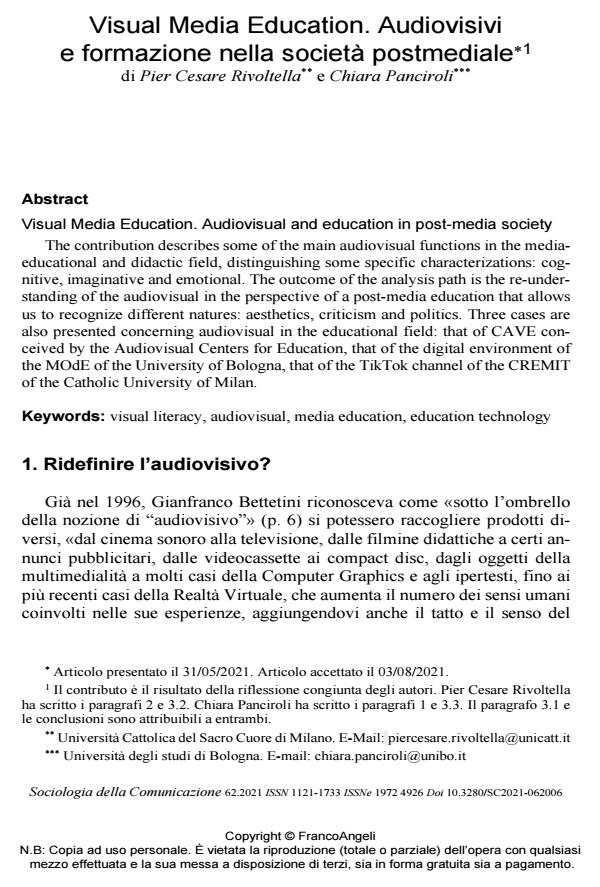Visual Media Education. Audiovisual and education in post-media society
Journal title SOCIOLOGIA DELLA COMUNICAZIONE
Author/s Pier Cesare Rivoltella, Chiara Panciroli
Publishing Year 2021 Issue 2021/62
Language Italian Pages 18 P. 87-104 File size 404 KB
DOI 10.3280/SC2021-062006
DOI is like a bar code for intellectual property: to have more infomation
click here
Below, you can see the article first page
If you want to buy this article in PDF format, you can do it, following the instructions to buy download credits

FrancoAngeli is member of Publishers International Linking Association, Inc (PILA), a not-for-profit association which run the CrossRef service enabling links to and from online scholarly content.
The contribution describes some of the main audiovisual functions in the me-dia-educational and didactic field, distinguishing some specific characterizations: cognitive, imaginative and emotional. The outcome of the analysis path is the re-understanding of the audiovisual in the perspective of a post-media education that allows us to recognize different natures: aesthetics, criticism and politics. Three cases are also presented concerning audiovisual in the educational field: that of CAVE conceived by the Audiovisual Centers for Education, that of the digital en-vironment of the MOdE of the University of Bologna, that of the TikTok channel of the CREMIT of the Catholic University of Milan.
Keywords: visual literacy, audiovisual, media education, education technology
- Cosa vuol dire essere “immersi” nell’apprendimento? Il rapporto tra esperienze immersive e apprendimento efficace: Delio De Martino, Maria Clara Dicataldo, in IUL Research 5/2023 pp.203
DOI: 10.57568/iulresearch.v4i7.417 - Higher Education Learning Methodologies and Technologies Online Laura Corazza, Anita Macauda, Chiara Panciroli, Alberto Parola, Pier Cesare Rivoltella, pp.59 (ISBN:978-3-031-29799-1)
- Proceedings of the 2nd International and Interdisciplinary Conference on Digital Environments for Education, Arts and Heritage Giorgia Mauri, Anita Macauda, Salvatore Messina, Chiara Panciroli, pp.178 (ISBN:978-3-031-73822-7)
Pier Cesare Rivoltella, Chiara Panciroli, Visual Media Education. Audiovisivi e formazione nella società postmediale in "SOCIOLOGIA DELLA COMUNICAZIONE " 62/2021, pp 87-104, DOI: 10.3280/SC2021-062006